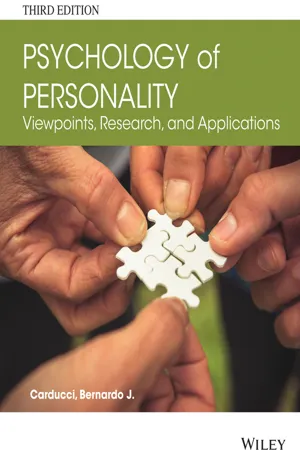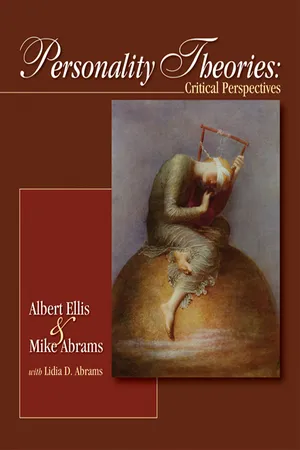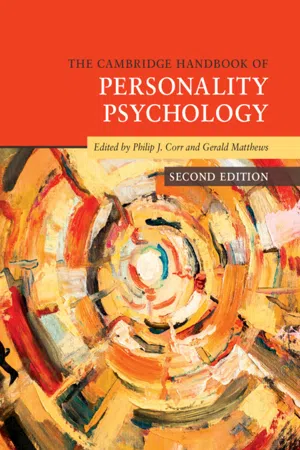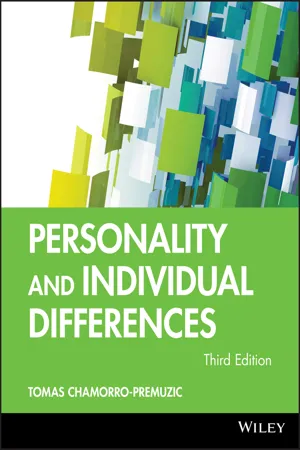Psychology
Introduction to Personality
"Introduction to Personality" is a foundational concept in psychology that explores the unique patterns of thoughts, feelings, and behaviors that distinguish individuals. It encompasses various theories and approaches aimed at understanding and explaining the complexities of human personality, including trait theories, psychodynamic theories, humanistic theories, and social-cognitive theories. The study of personality is crucial for comprehending human behavior and individual differences.
Written by Perlego with AI-assistance
Related key terms
1 of 5
11 Key excerpts on "Introduction to Personality"
- eBook - PDF
Psychology of Personality
Viewpoints, Research, and Applications
- Bernardo J. Carducci(Author)
- 2015(Publication Date)
- Wiley(Publisher)
© franckreporter / iStockphoto Part I The Scope and Methods of Personality An Introduction to the Psychology of Personality W elcome to the study of the psychology of personality. Part I serves as a general intro- duction to the study of personality. As part of this introduction, you will be exposed to information that will help you understand the scope of per- sonality psychology by illustrating how personality is defined and what constitutes the study of per- sonality psychology. You will also be exposed to the methods of personality psychology by con- sidering the research strategies and assessment techniques personality psychologists use to gather information while studying the underlying nature, operation, and development of personality, as well as how this information can be used in applications to our everyday living experiences. The information you gain in Part I will lay the foundation for all of the viewpoints, research, and applications of personality psychology you will be exposed to in the remainder of this book. 1 The Psychology of Personality An Overview Chapter Overview Defining Personality How Personality Psychologists Define Personality Common Features of Definitions of Personality The Scope of Personality Psychology Theory Development Personality Research Personality Development Personality Assessment Applications in Personality Psychology Research Methods in Personality Psychology The Clinical Approach The Correlational Approach The Experimental Approach Research Ethics Some Ethical Concerns Some Solutions to Ethical Issues Chapter Summary Glossary Chapter Overview: A Preview of Coming Attractions P eople use the word personality every day. They say, “He has such a dynamic personality” or “She gets her personality from her mother’s side of the family.” Yet most people do not really understand what the study of personality is all about. Chapter 1 sets the stage for our study of personality. - eBook - ePub
Personality Theories
Critical Perspectives
- Albert Ellis, Mike Abrams, Lidia Abrams(Authors)
- 2008(Publication Date)
- SAGE Publications, Inc(Publisher)
Chapter 1The Study of PersonalityIntroduction
Chapter Goals- Provide an overview of the controversies in the field of personality
- Explain the purpose and utility of studying personality to mental health professionals
- Review the various definitions of human personality
- Offer insights into the history of personality theories
- Introduce some of the methods used to measure or evaluate personality
- Present some of the major personality theorists who have developed the concepts we will be studying
S ubdisciplines of psychology such as social psychology, cognitive psychology, and industrial psychology endeavor to find common principles that will explain everyone’s behavior. These subfields have achieved considerable success in doing so, since we are all similar in many ways. Despite our similarities, however, there is little doubt that each human being is unique—different from every other individual on the planet. Seeking to understand human commonalities and seeking to account for individual differences are complementary, insofar as we cannot fully apprehend differences if we cannot identify our common characteristics.Personality psychology looks for answers to numerous questions. In what ways do human beings differ? In what situations and along what dimensions do they differ? Why do they differ? How much do they differ? How consistent are human differences? Can they be measured? These are the issues that this text will explore. An important aspect of this exploration will be a critical examination of the numerous theories that have been proposed to explain personality. Some of these are competing and contradictory while others are supportive and complementary.Personality psychology was a latecomer among the various disciplines within psychology. Before it was adopted as a subject for study, however, it was already well established as a topic of discussion in the public domain. People have always been practicing personality psychology whether they have recognized it or not. When we seek the right person for a mate, our judgment of his or her personality is indispensable in evaluating our hoped-for compatibility. And are personnel directors really doing anything other than analyzing the applicant’s personality during a job interview? Similarly, when we describe a physician as a “good doctor,” have we really assessed the caliber of his or her medical knowledge? Or are we saying that we are satisfied with the doctor’s professional persona? When we listen to political speeches, how do we rate the orators? Are we looking at their command of the issues or their political acumen? Or is it essentially their personality that we appraise? In most cases, it would seem the latter. These examples illustrate the omnipresence of informal personality assessment. It is a subject of universal interest and continual relevance in all human interactions. On the other hand, although the study of personality is compelling and important, personality as such is also very hard to pin down. - No longer available |Learn more
- (Author)
- 2014(Publication Date)
- The English Press(Publisher)
________________________ WORLD TECHNOLOGIES ________________________ Chapter-1 Introduction to Personality Psychology Personality psychology is a branch of psychology that studies personality and individual differences. Its areas of focus include: • Constructing a coherent picture of a person and his or her major psychological processes • Investigating individual differences , that is, how people can differ from one another. • Investigating human nature, that is, how all people's behaviour is similar. Personality can be defined as a dynamic and organized set of characteristics possessed by a person that uniquely influences his or her cognitions, motivations, and behaviors in various situations. The word personality originates from the Latin persona , which means mask. Significantly, in the theatre of the ancient Latin-speaking world, the mask was not used as a plot device to disguise the identity of a character, but rather was a convention employed to represent or typify that character. The pioneering American psychologist, Gordon Allport (1937) described two major ways to study personality, the nomothetic and the idiographic. Nomothetic psychology seeks general laws that can be applied to many different people, such as the principle of self-actualization, or the trait of extraversion. Idiographic psychology is an attempt to understand the unique aspects of a particular individual. ________________________ WORLD TECHNOLOGIES ________________________ The study of personality has a broad and varied history in psychology, with an abundance of theoretical traditions. The major theories include dispositional (trait) perspective, psychodynamic, humanistic, biological, behaviorist and social learning perspective. There is no consensus on the definition of personality in psychology. Most researchers and psychologists do not explicitly identify themselves with a certain perspective and often take an eclectic approach. - Philip J. Corr, Gerald Matthews(Authors)
- 2020(Publication Date)
- Cambridge University Press(Publisher)
Some definitions emphasize integration of personality into a whole person. From his personological trait approach, Gordon Allport (1937) defined personality as “the dynamic organization within the individual of those psychophysical systems that determine his unique adjust- ments to the environment” (p. 48). A definition that gives a modern twist to personological integration is offered by McAdams and Pals (2006), who define personality as “an individual’s unique variation on the general evolutionary design for human nature, expressed as a developing pat- tern of dispositional traits, characteristic adaptations, and integrative life stories complexly and differentially situ- ated in culture” (p. 212). The emphasis on dynamics and development in these two personological definitions reminds us that some theories emphasize function and change, in contrast to the typically more static trait emphasis on description. If commonality is to be found among these diverse definitions, it may be a frequently shared assumption that an individual’s personality begins with biologically innate components, both those shared with others and those that are distinct because of heredity or other influences; that over the life course, these innate tendencies are influenced by many factors, including family experience and culture; and that the resulting pat- tern of habitual behaviors, cognitions, emotional patterns and so on constitutes an individual’s personality. Sometimes later developed, more rational, “cooler” 13 aspects of personality hold potentially dangerous primi- tive, more emotional, “hotter” forces in check. Sometimes they do not. If we accept Carl Jung’s argument, too much of the former (rational) aspects can even be devastating to the psyche.- eBook - PDF
- Tomas Chamorro-Premuzic(Author)
- 2015(Publication Date)
- BPS Blackwell(Publisher)
These comprehensive and up-to-date definitions refer to sta- ble, internal and causal processes, with both mental and physical aspects, that account for an individual’s typical manifestations of behavior, emotion, and thought in every- day life. In simple terms, then, we could define personality as that which makes a person different or similar to others. As Carver and Scheier (2000, p. 5) note, there are certain universal characteristics of the human race and particular features of individuals. We all for example experience stress, and the elevated cortisol that goes with it, and we all suffer the immune suppressive effects thereof. But each of us is unique too. FIGURE 2.1 Situational (states), idiographic, and nomothetic (types and traits) approaches to the study of personality (p = person) 1) Situational: personality as inconsistent states/behaviors. 2) Idiographic: describes different people in different terms. 3) Nomothetic: describes different people using same terms (extremes) or traits (continuum). p1 p2 p2 Types Traits p1 p1 p2 p2 28 PERSONALITY AND INDIVIDUAL DIFFERENCES That means that some of us may be particularly likely to experience stress during university exams, while others may do so when meeting new people or traveling by plane. Furthermore, some of us may perform best under pres- sure, while others may only do well under relaxed conditions. What makes you anxious? Research on personality traits deals with the fundamental differences and similarities between individuals. Beginning with a general classification or tax- onomy of the stable and observable patterns of behavior, it goes on to assess the extent to which individuals differ on these variables or traits. - No longer available |Learn more
Psychology Applied to Modern Life
Adjustment in the 21st Century
- Wayne Weiten, Dana Dunn, Elizabeth Hammer(Authors)
- 2014(Publication Date)
- Cengage Learning EMEA(Publisher)
Cengage Learning reserves the right to remove additional content at any time if subsequent rights restrictions require it. 64 CHAPTER 2 Key Ideas THE NATURE OF PERSONALITY ● The concept of personality explains the consistency in individu- als’ behavior over time and situations while also explaining their distinctiveness. Personality traits are dispositions to behave in certain ways. ● Some theorists suggest that the complexity of personality can be reduced to just five basic traits: extraversion, neuroticism, open- ness to experience, agreeableness, and conscientiousness. The Big Five traits predict important life outcomes, such as grades, occupa- tional attainment, divorce, health, and mortality. PSYCHODYNAMIC PERSPECTIVES ● Freud’s psychoanalytic theory emphasizes the importance of the unconscious. Freud described personality structure in terms of three components (id, ego, and superego), operating at three levels of awareness, that are involved in internal conflicts, which generate anxiety. ● According to Freud, people often ward off anxiety and other unpleasant emotions with defense mechanisms, which work through self-deception. He described five psychosexual stages that children undergo in their personality development. ● Jung’s analytical psychology stresses the importance of the col- lective unconscious. Adler’s individual psychology emphasizes how people strive for superiority to compensate for feelings of inferiority. BEHAVIORAL PERSPECTIVES ● Behavioral theories view personality as a collection of response tendencies shaped through learning. Pavlov’s classical condition- ing can explain how people acquire emotional responses. ● Skinner’s model of operant conditioning shows how conse- quences such as reinforcement, extinction, and punishment shape behavior. Bandura’s social cognitive theory shows how people can be conditioned indirectly through observation. He views self-efficacy as an especially important personality trait. - eBook - PDF
- Ronald Comer, Elizabeth Gould, Adrian Furnham(Authors)
- 2014(Publication Date)
- Wiley(Publisher)
Maddi (1989, p. 2) You probably do a lot of thinking about personality . Are you, personality speaking, more like your mother or your father? Do you know what your dark or shadow side is? Maybe you have also spent time thinking and talking about the varying personalities of your friends. How is it that some of your friends have such odd tastes? What pleasures can they possibly get from such strange pastimes? And what on earth do they see in their romantic partners? Thinking about people ’s unique characteristics allows us to give context to their behaviour and to try to predict how they might react in a given situation. Psychological research has historically focused on the divide between nature and nurture explanations of person- ality development. Increasingly, however, psychologists have come to acknowledge that these two factors interact to shape personality. In this chapter, we first explore different perspec- tives on personality – the psychodynamic, humanistic, trait, situationist and interactionist perspectives. Many of these perspectives are more of historical interest because without doubt the trait perspective is the dominant one in modern personality theory. We then look at the important role played by genetic pre- dispositions in personality and what researchers have found out about the contributions of both genetic and environmen- tal factors. Next, we examine whether personality differs depending on gender and culture. And, finally, we describe various personality disorders and consider how psycholo- gists assess personality in individuals. In fact, there has been something of a renaissance in what is called differential psychology because of four things. First, growing agreement about the description and understand- ing of the basic dimensions of personality. Second, a greater understanding of the heritability of personality and the role of the social environment in shaping it. - eBook - ePub
- Graham C. Davey(Author)
- 2018(Publication Date)
- Wiley(Publisher)
14 PersonalityTOM FARSIDESROUTE MAP OF THE CHAPTER
After an introductory section outlining what personality is and some of its key aspects, this chapter reviews four of the main approaches psychologists use to understand personality. The first of these is psychodynamic. This stems from Sigmund Freud’s interpretation of data he gathered during personal introspection and observation of the world around him. Second is the trait approach, which fundamentally involves recording verifiable regularities in people’s psychological characteristics. Whereas psychodynamic theory is often thought to present people as somewhat dark and dangerous, the third, humanistic, approach stresses people’s capacity for positive personal and social growth. The fourth and final approach emphasizes people’s potential to develop in all manner of ways, good and bad. This social cognitive approach recognizes that personality development is heavily influenced by people’s understanding of what it is possible for them to do and become.CHAPTER OUTLINE
- Introduction to Personality
- PSYCHODYNAMIC PERSONALITY THEORY
- TRAIT PERSONALITY THEORY
- HUMANISTIC PERSONALITY THEORY
- SOCIAL COGNITIVE PERSONALITY THEORIES
- CONCLUSIONS AND FUTURE DIRECTIONS
- CHAPTER SUMMARY
Introduction to Personality
LEARNING OBJECTIVE 14.1
Describe key features of how the word ‘personality’ can be conceptualized.Humans: Individuals and typesStudents are often attracted to psychology because they want to ‘understand people’. This desire has three related but distinct components. First, students want to know ‘what makes people tick’. They suspect that all people share some fundamental psychological characteristics that could be understood and perhaps used to predict and control people’s behaviour. These students are interested in ‘human psychology’. Second, they want to understand specific individuals, often themselves. They want to know what gives particular people the specific characteristics they have and what might make them change, ideally for the better. These students are interested in ‘individual psychology’. Finally, some students are interested in potentially distinct types of person (e.g. men or psychopaths). They want to know what, if anything, makes these sorts of people alike and different from other people. These students are interested in taxonomic or ‘differential psychology’. Personality psychology – the psychology of persons, personalities, and personhood – is the branch of psychology that most directly addresses these issues. Because of its various concerns, aspects of personality psychology sometimes have specific or alternative names, such as ‘personology’ or ‘the psychology of individual differences - eBook - ePub
- Paul Smith, Marilyn Farmer, Wendy Yellowley(Authors)
- 2013(Publication Date)
- Routledge(Publisher)
When we meet someone for the first time, we often form immediate impressions based on very limited information. Perhaps the clothes they are wearing, the way they talk or even the firmness of their handshake will start to form a picture in our mind about what this person might be like. If we continue to get to know the person, it is more likely that we will adapt our first impressions and begin to base our estimation of the person on his or her more consistent and enduring ways of behaving. So personality refers to the unique characteristics that determine and influence how people act and behave.The sort of experience described above is the focus of this particular chapter; the implications of individual personality, the process of perception and how we form attitudes hold much relevance for organizational life.3.2 Individual differences and personality
KEY TERM Personality:the characteristics of an individual that make the individual unique and shape his or her behaviour.Reflective questionsThere is much debate centred on whether personality is inherited (nature) or developed in response to environmental conditions (nurture). Which side of the debate would you support, and why?If you were to ask a friend to use three words to describe you, what do you think they would be? If you were to ask a colleague at work to use three words to describe you, what do you think they would be? Do they differ? If so, why might this be?All individuals are unique, but although we are all different, we all share several things. Research into personality has provided a fascinating wealth of material about which there remains controversy and debate. This chapter will attempt to provide a snapshot of the varying explanations of personality to whet the reader's appetite.The study of personality dates back to the Middle Ages, when the first examples of personality theory suggested that personality was linked to our physiological make-up and the balance of our bodily fluids. People were characterized as having a cheerful, energetic and lively personality if they had a greater amount of blood, while those with a higher level of phlegm were said to be typically calm and placid. Those with a lot of ‘black bile’ were classified as gloomy individuals, and those with more yellow bile were said to be aggressive and hasty. This sort of approach to personality attempted to provide a classification or typology system in which every individual could fit. Since then, other researchers, such as Sheldon (1954), have attempted to produce typologies of personality, using bodily shape as an indicator of personality type, with the mesomorph (athletic, muscular people), endomorph (plump, rounded people) and ectomorph (thin, fragile people) being the main indicators. - Lorelle J. Burton, Drew Westen, Robin M. Kowalski(Authors)
- 2022(Publication Date)
- Wiley(Publisher)
According to Gordon Allport (1937; Allport & Odbert, 1936), who developed the trait approach to personality, the concept of trait has two separate but complementary meanings. On the one hand, a trait is an observed tendency to behave in a particular way. On the other, a trait is an inferred, or hypothesised, underlying personality disposition that generates this behavioural tendency. Presumably, a tendency to be cheerful (an observed trait) stems from an enduring pattern of internal processes, such as a tendency to experience positive affect, think positive thoughts or wish to be perceived as happy (inferred dispositions). How can we measure traits? The most straightforward way is the same way people intuitively assess other people’s personalities. Observe their behaviour over time and in different situations. Because extensive observation of this sort can be very cumbersome and time consuming; however, psychologists often use two other methods. One is to ask people who know the participant well to fill out questionnaires about the person’s personality. The second, more commonly used method is to ask participants themselves to answer self-report questionnaires. For example, self-report personality inventories are often used in non- clinical settings, such as schools and organisations, and test for traits such as sociability, responsibility and sense of wellbeing. They may also be used in clinical settings. For example, the scales used to examine personality on the Minnesota Multiphasic Personality Inventory (MMPI) were based on data from psychiatric patients suffering from depression, schizophrenia and paranoia (Dahlstrom, 1993; Hathaway & McKinley, 1940, 1943). Pdf_Folio:688 688 Psychology To describe personality from a trait perspective, we must know not only how to measure traits but also which ones to measure.- eBook - PDF
- Douglas Bernstein, , , (Authors)
- 2015(Publication Date)
- Cengage Learning EMEA(Publisher)
Together, these state-ments describe personality traits —the tendencies that help direct how a person usually thinks and behaves (Cervone & Pervin, 2013). The trait approach to personality makes three main assumptions: 1. Personality traits are relatively stable, and therefore predictable, over time. So a gentle person tends to stay that way day after day, year after year (Cervone & Pervin, 2013). 2. Personality traits are relatively stable across situations, and they can explain why people act in predictable ways in many different situations. A person who is com-petitive at work will probably also be competitive on the tennis court or at a party (Roberts, Woods, & Caspi, 2008). 3. People differ in how much of a particular personality trait they possess; no two people are exactly alike on all traits. The result is an endless variety of unique personalities. In short, psychologists who take the trait approach see personality as a combina-tion of stable internal characteristics that people display consistently over time and across personality traits A set of stable characteristics that people display over time and across situations. trait approach A perspective on personality that views it as the combination of stable characteris-tics that people display over time and across situations. Copyright 2016 Cengage Learning. All Rights Reserved. May not be copied, scanned, or duplicated, in whole or in part. Due to electronic rights, some third party content may be suppressed from the eBook and/or eChapter(s). Editorial review has deemed that any suppressed content does not materially affect the overall learning experience. Cengage Learning reserves the right to remove additional content at any time if subsequent rights restrictions require it. 464 Personality situations (Pervin, Cervone, & John, 2005). Trait theorists try to measure the relative strength of the many personality characteristics that they think may be present in everyone (see Figure 13.2).
Index pages curate the most relevant extracts from our library of academic textbooks. They’ve been created using an in-house natural language model (NLM), each adding context and meaning to key research topics.










